Cannondale Moterra SL
Wheel Size: 29’’ front / 27.5’’ rear
Travel: 150 mm rear / 160 mm front
Geometry Highlights:
- Sizes offered: S, M, L, XL
- Headtube angle: 62.5°/ 63.7° (adjustable)
- Seat tube angle: 77.0°
- Reach: 470 mm (size Large)
- Chainstay length: 449 mm to 458 mm (varies by frame size)
Drive System Highlights:
- Motor: Shimano EP801
- Torque: 85 Nm
- Power: 600 Watts
- Battery: 601 Wh
- Display: Shimano SC w/ EM800 / EW-SW310 integrated top tube on/off switch
Material: Carbon Fiber
Price: Complete bikes $7,000 to $14,000
Stated Weight: 19.5 kg / 42.99 lb (Size Medium, Lab71 Build)

Intro
Cannondale has a long history of doing wild and innovative stuff with their bike designs. Some of those things worked, some were less well received, but it’d be hard to accuse them of just following the rest of the industry’s lead.
I’m happy to report that the new Moterra SL looks to be quite the return to form in this department — it’s a wildly light full-power eMTB.
The Moterra SL’s (stated) weight is awfully competitive with a lot of lower-powered eMTBs out there (and not that far off some of the chunkier regular bikes we’ve been on). So, how has Cannondale pulled it off, and what kinds of compromises did they make to get there? Let’s take a look:

The Frame
To achieve the low weight that they were looking for in the Moterra SL frame, Cannondale borrowed carbon technology from their XC World Cup Scalpel model. They also claim to have been inspired by Formula One race car suspension, though the details of what they drew from that arena aren’t specified.
Cannondale’s FlexPivot design essentially acts as the Horst pivot in their “true” four-bar suspension system, just with an engineered flex point in the chainstays taking the place of a traditional pivot.

Flex-stays are more common on XC and shorter-travel trail bikes, though there are 160+ mm travel bikes with flex-stay suspension designs. But we have yet to see a flex-stay implementation on a full-power eMTB, so it will be interesting to see how the FlexPivot manages the additional forces from a motor capable of 85 nm of torque and 600 watts of peak power.
Headset cable routing is an option, but credit to Cannondale for also putting cable ports in the frame of the SL1 and SL2 builds so that the decision as to where to route the cables is up to the rider — a welcome touch. Although all three builds appear to have the same Series 1 Carbon frames, the LAB71 frame is unique and does not have cable ports. I have to admit this is a bit baffling since it means an entirely different frame just to eliminate cable ports — we’ve reached out to Cannondale to see if there are other differences apart from the cable ports in the LAB71 frames.
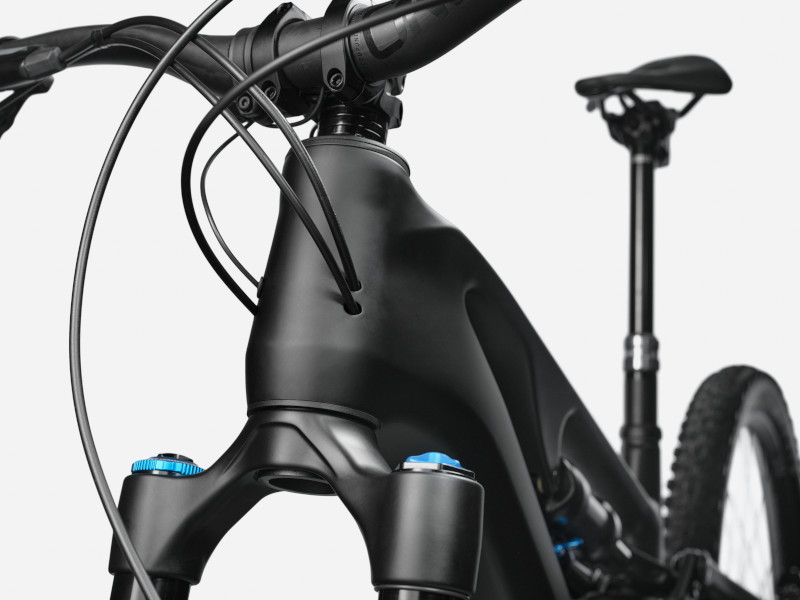
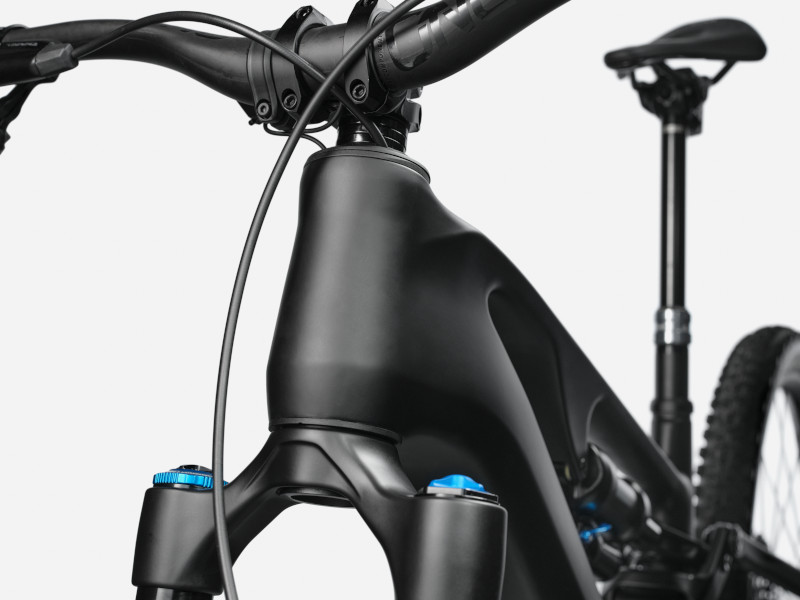



The Moterra SL frame is prepped to accept an Acros adjustable headset, with drop-in cups and pins that interface with notches in the headtube to set their clocking. Rotating the cups 180° gives the Moterra SL 1.2° of head angle adjustment. Cannondale will also be offering 0° cups that will put the head angle at a fixed 63.1°. Additionally, the frame is equipped with a flip chip for switching between 27.5” and 29” rear wheels, though all the stock builds come with mixed wheel sizes.
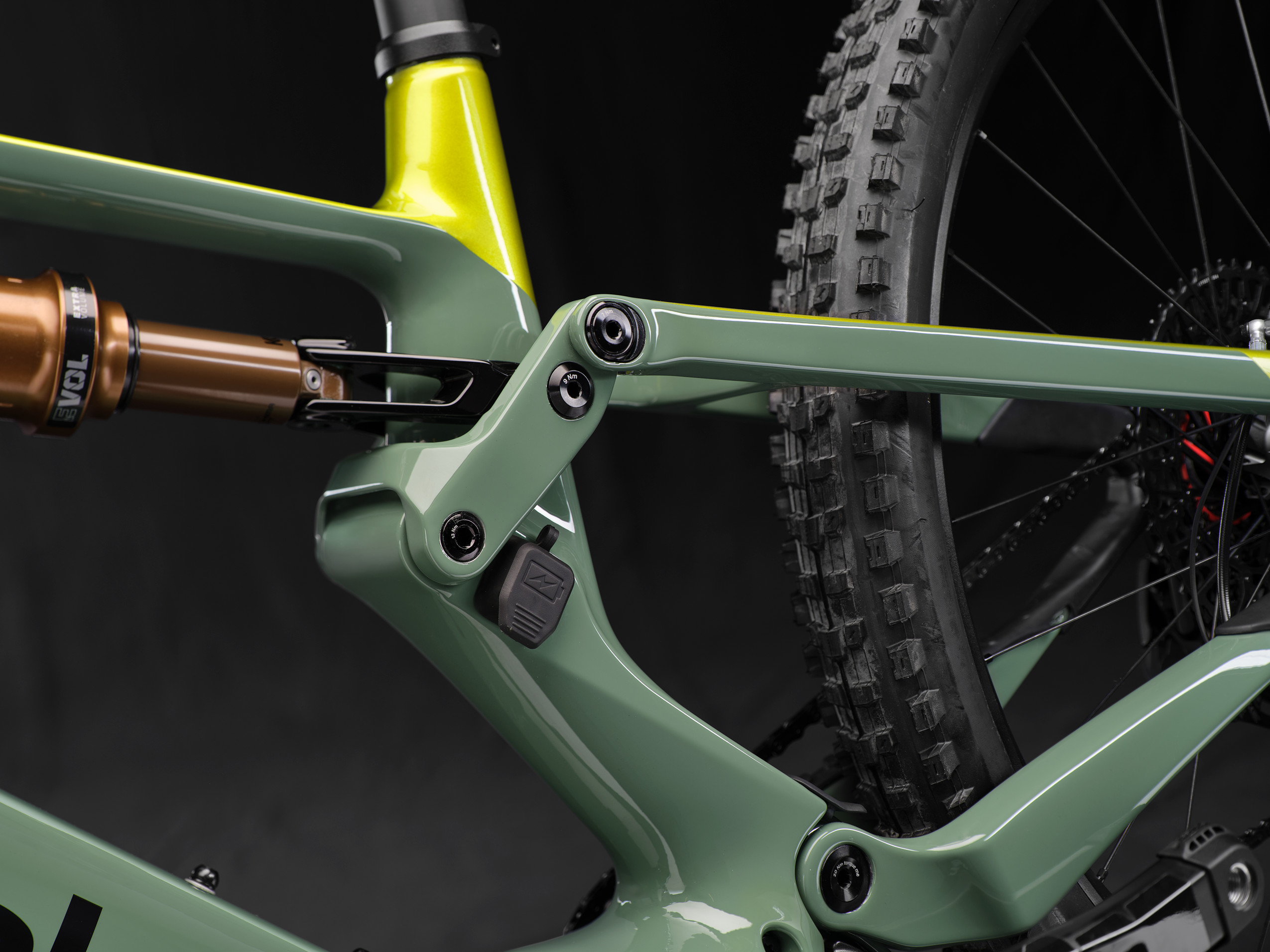

There’s also room for a water bottle inside the front triangle on all four sizes. The frame does have a UDH, which it must, since it has builds spec’d with SRAM’s AXS Transmission. Other frame features include chainstay protection and an integrated bash guard to protect the drive unit.
Drive System
The Moterra SL comes equipped with the Shimano EP801 drive system. At a claimed weight of 19.5 kg / 42.99 lb (Lab71 build, size Medium), Cannondale says that the Moterra SL is the lightest full-power eMTB available. We don’t have any reason to dispute that since we can’t think of any currently available full-power eMTBs that are lighter.
Since the weight of the EP801 motor is a fixed 2.7 kg / 5.95 lb, much of the Moterra SL’s weight savings have come from the battery. Unlike Bosch, Shimano open sources its battery technology, which allows brands to design and build their own. I say “build” loosely, since many brands opt to use third-party battery companies to manufacture their batteries. The Moterra SL’s custom 601 Wh battery weighs a claimed 3.1 kg, or about 6.8 lbs. Battery density is a measurement of capacity in watt-hours per weight, and 3.1 kg (claimed) for 601 Wh equates to one of the highest-density batteries we have seen to date. For reference, Bosch states their 625 Wh PowerTube battery weighs approximately 3.65 kg. Additionally, Cannondale includes the wiring harness in their claimed weight for the battery, which makes it even more impressive.

With 85 Nm of torque and 600 watts of peak power, the Shimano EP801 drive system is a competitive option in the full-power drive system category. We spent time on the prior-generation Shimano EP8 motor while testing the Pivot Shuttle LT and the new EP801 on the Canyon Torque:ON, and got along with both versions quite well. The updated EP801 drive system claims to deliver peak torque throughout a wider cadence range while also bumping power output from 500 watts up to 600 watts. Other upgrades over the previous EP8 motor include a reported improvement in heat management, compatibility with Shimano’s FREE SHIFT and AUTO SHIFT technologies, as well as CAN and ACC ports for increased connectivity to external devices.
All three Moterra SL build levels will come with the handlebar-mounted Shimano SC-EM800 display and the EW-SW310 integrated top tube controller, which houses the on/off switch, battery level display, and an assist mode controller. For a tidier cockpit, the handlebar-mounted display can be removed.
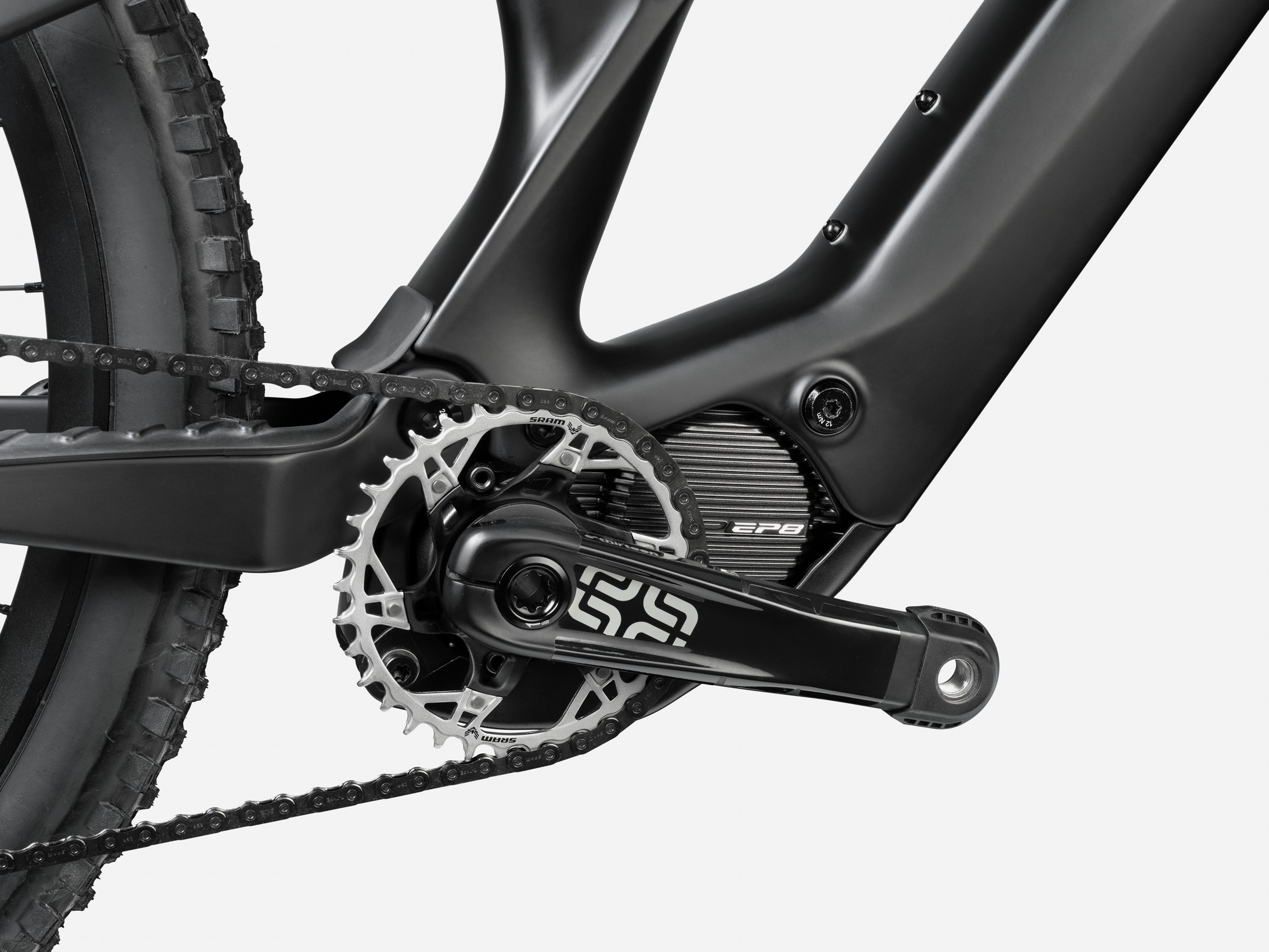
Fit & Geometry
The Moterra SL is available in four sizes: Small, Medium, Large, and Extra Large. The reach starts at 420 mm for the size Small, then grows 25 mm from size Small to Medium and again from Medium to Large (445 and 470 mm, respectively), with a 35 mm jump between size Large and Extra Large, to 505 mm. Cannondale describes the Moterra SL as having the long reach of a modern Trail bike, but those numbers are a little on the conservative side these days.
I’ve gone on record stating how I prefer a higher stack height on eMTBs, and the Moterrra SL does not disappoint, at 648 mm in size Large. And with the size Large having a reach of 470 mm (definitely on the shorter side), the higher stack height will also help keep that short-ish reach from shrinking since fewer spacers will most likely be needed under the stem.
Probably the most noteworthy geometry number is the incredibly slack 62.5° head angle. Just a few months ago, I was writing about how the Devinci E-Troy’s 63.5° head angle was category-pushing, but now it has been out-slacked by the Moterra SL. However, should 62.5° be a bit too slack for you, rotating the Acros adjustable headset cups will steepen it to 63.7°.
The chainstays range from 449 mm to 458 mm, which is on the long side for a mixed-wheel size bike in particular. But the Moterra SL has flip chips enabling it to run a 29” rear wheel, making the longer chainstays more in line with the rest of the market. Cannondale states the flip chips will keep the Moterra SL’s geometry in the 29er configuration very close to the mullet’s numbers.
Lastly, combining long chainstays and a very slack head angle inevitably will result in a correspondingly long wheelbase. The Moterra SL’s 1283 mm wheelbase (size Large, mixed-wheel size) will be the longest of any of the eMTBs I’ve been on to date. It will be interesting to see how all the Moterra SL’s geometry numbers will play out on the trail.
The Builds
Cannondale has kept it simple with just three builds offered for the Moterra SL, and I’m going to simplify it even further and call out the mid-range SL1 build as the clear winner. The entry-level SL2 build looks like a solid value at $7,000, and while it is a good price for a well-equipped full-power eMTB, some areas are lacking. For instance, it would be nice to match the Fox Float X Performance Elite shock with the Performance Elite version of the Fox 36, which would then give you the excellent Grip2 damper. Also, 180 mm rotors on a full-powered eMTB are not ideal. Granted, that is a fairly inexpensive upgrade, but it really should come with at least 200 mm rotors from the factory.
The SL1 build, on the other hand, has no black eyes that I can see. $8,750 for a carbon eMTB with a Shimano EP801 drive system, 601 Wh battery, Fox Factory suspension, SRAM XO Transmission, SRAM Code Silver Stealth brakes, and DT Swiss XM 1700 wheels is a bonafide steal.



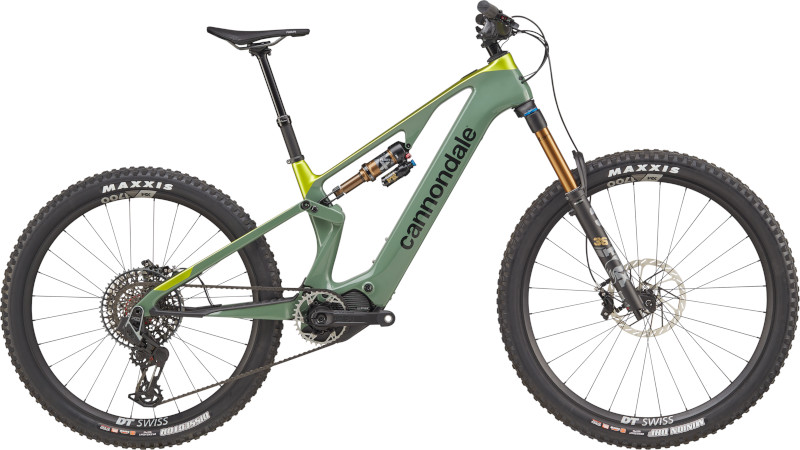

Another thing worth mentioning is dropper-post travel. All the builds max out at 170 mm of travel for sizes Medium through Extra Large. We would like to see longer-travel dropper posts offered on the larger frames, but judging by the kink in the seat tube, the Moterra SL may be significantly limited in maximum seatpost insertion depth.
Here are the highlights of the three Moterra SL builds:
- Frame: Series 1 Carbon
- Drivetrain: Shimano Deore 6100 12spd with Shimano XT derailleur
- Motor: Shimano EP801
- Battery: 601 Wh
- Fork: Fox 36 Performance (160 mm)
- Shock: Fox Float X Performance Elite
- Brakes: Shimano Deore 6120 four-piston with 180 mm rotors
- Wheels: Formula DC 11732H front hub / DT Swiss 370 Hybrid rear hub with Stan’s Arch MK4 rims
- Dropper Post: Cannondale DownLow Dropper (SM: 150 mm; MD – XL: 170 mm)
- Frame: Series 1 Carbon
- Drivetrain: SRAM XO Transmission
- Motor: Shimano EP801
- Battery: 601 Wh
- Fork: Fox 36 Factory Grip2 (160 mm)
- Shock: Fox Float X Factory
- Brakes: SRAM Code Silver Stealth with 200 mm rotors
- Wheels: DT Swiss XM 1700
- Dropper Post: Cannondale DownLow Dropper (SM: 150 mm; MD – XL: 170 mm)
- Frame: Series 1 Carbon
- Drivetrain: SRAM XX Transmission
- Motor: Shimano EP801
- Battery: 601 Wh
- Fork: Fox 36 Factory Grip2 (160 mm)
- Shock: Fox Float X Factory
- Brakes: SRAM Code Ultimate Stealth with 200 mm rotors
- Wheels: DT Swiss XMC 1501
- Dropper Post: Rockshox Reverb AXS (SM: 150 mm; MD – XL: 170 mm)
FULL REVIEW
2024 has been the year of the lightweight eMTB, and at 45.6 lbs / 20.6 kg, the Cannondale Moterra SL definitely qualifies as one — but it also has a full-power Shimano EP801 motor with a 601 Wh battery. So while it has a similar weight as many light-assist eMTBs it has all the benefits of a full-power drive system. The Moterra SL is one of the most exciting eMTBs to come out recently, and we now have a whole lot of miles on it so it’s time to check in and see how this groundbreaking eMTB performed.
But before we dive in, check out our Head-to-Head video comparing the Moterra SL to the Mondraker Dune:
Fit & Sizing
Simon Stewart (6’, 170 lbs / 183 cm, 77 kg): Our size Large Moterra SL presented no real surprises regarding sizing — once I got on it, there was no question that the size Large was the right choice for me. That said, Cannondale describes it as having the long reach of a modern Enduro bike, but at 470 mm for a size Large, it’s actually on the shorter side of what we’re seeing for reach numbers in that category.
Overall the fit on the Moterra SL works quite well for me. I find the compact upright position due to the relatively short 470 mm reach (size Large) to be comfortable, and it doesn’t feel cramped which I was a tiny bit worried about when looking over the geometry numbers when writing the First Look.
The size Large has a nice high stack height, which made it possible for both me and Dylan to find our preferred bar height without the need for a handlebar swap. I prefer higher bars than Dylan so we usually end up moving stems up and down, and often swapping handlebars too. In this case, just moving the stem up and down the steerer tube was enough to make us both happy.
Dylan Wood (5’10.5”, 160 lbs / 179 cm, 72.5 kg): Yep, the Large Moterra SL made for an extremely comfortable and familiar fit for me, which is no surprise, given that I am right in the middle of their recommended sizing chart for the Large. As Simon mentioned, the 470 mm reach is slightly on the shorter side for today’s modern Trail/Enduro bikes, and I wouldn’t want it any shorter.
I am quite happy with just about every aspect of the bike’s fit, including the stack height, which on paper, I thought might have been a bit too high for my taste at 648 mm for the size Large. But, I found myself running 10 mm of spacers under the stem, in part due to this bike’s knack for tackling steep terrain — more on that in the “Descending” section.
Climbing
Simon: The Moterra SL has a relatively upright seated climbing position that I find quite comfortable, and due to the slack headtube angle (particularly in the slack 62.5° setting) and long chainstays giving the Moterra SL a fairly long wheelbase, I found myself settling into a pretty centered position while seated and standing. That said, the Moterra SL isn’t super sensitive to body position, and you can move around a good bit to make yourself comfortable without negatively affecting the handling.
It’s not surprising that the Moterra SL’s FlexPivot suspension layout has an energetic and lively feel. Most “flex stay” bikes have that in common, and combined with the low 45.6 lb / 20.6 Kg weight, the Moterra SL has a light-on-its-feet feel and is a lot easier to maneuver than its long wheelbase may suggest.

While not as traction-rich as bikes like the Mondraker Dune XR, Devinci E-Troy, and Orbea Wild, the Moterra SL doesn’t embarrass itself either — but due to the combination of the powerful motor and lively suspension, it is a little more dependent on good technique to maintain traction than the bikes listed above. The Moterra SL responds well to a smooth cadence since it can get a little loose in the rear end when attacking particularly tricky sections with a choppy pedal stroke. That is by no means a bad thing — I like it because it is torquey at a slow cadence, but it can be unforgiving as a result.
On paper, the slack 62.5º (the setting it comes in) head angle doesn’t look particularly well-suited to steep, technical climbing, but the Moterra’s long-ish chainstays and 77º seat tube angle help reign it in. Of course, it doesn’t hurt to have the full power of the Shimano EP801 motor underneath you to keep the climbing speed high, but you still need to get forward on the saddle a good bit when the climbing gets really steep. That said, like Dylan, I preferred the steeper 63.7º head angle made possible by the Acros adjustable headset (1.2º of adjustability) — which allowed me to stay more centered while seated and drop the speed a hair to climb with a more precise approach.
Dylan: I agree, the Moterra tackles just about any climb, all while being comfortable to pedal on, whether you’re seated or standing. It is surprisingly maneuverable on tight, uphill switchbacks, despite its long wheelbase, and a big sweet spot out of the saddle is a perk that’s probably brought on by how much distance there is between the wheels of the Moterra SL. You can find the limits of traction on this bike fairly easily, so it does require a more precise approach than the ultra-planted eMTBs out there like the Mondraker Dune XR that Simon mentioned.
Like Simon, I found myself preferring the steeper of the two head tube angle settings on the Moterra SL. At 63.7º, the “steep” position is still pretty slack in the grand scheme of things. I found that, in the 62.5º head tube angle setting, the front end was prone to wandering on extremely steep climbs, often throwing me off route. I had several instances where, in the steeper setting, I went back to climbs that I failed in the slacker setting, and was able to successfully clean them due to having an easier time keeping the bike on the right line.
Descending
Simon: Long and slack geometry tends not to result in particularly playful bike, but I found the Moterra SL to be surprisingly lively and easy to throw around. Much of that credit goes to the active, lively suspension, and the compact fit. Cannondale’s FlexPivot suspension has plenty of pop, and combined with the Moterra SL’s low weight, encourages looking for trail features to get the Moterra SL in the air. Pulling the front end up into a manual, the Moterra SL’s low weight is noticeable over other full-power eMTBs that carry more weight in the downtube due to bigger and heavier batteries.
Sometimes the Moterral SL behaves like a lot of other mixed wheel bikes, feeling playful and slashy, but then stuff it hard into a corner and it starts to feel less like one as it fights the back end stepping out, and is more apt to go into a two-wheel drift. Putting more weight on the front end with a forward adjustment in body position helps by giving the front wheel more traction and lightening up the rear, but it feels a bit exaggerated to me, and besides, two-wheel drifts are still fun.
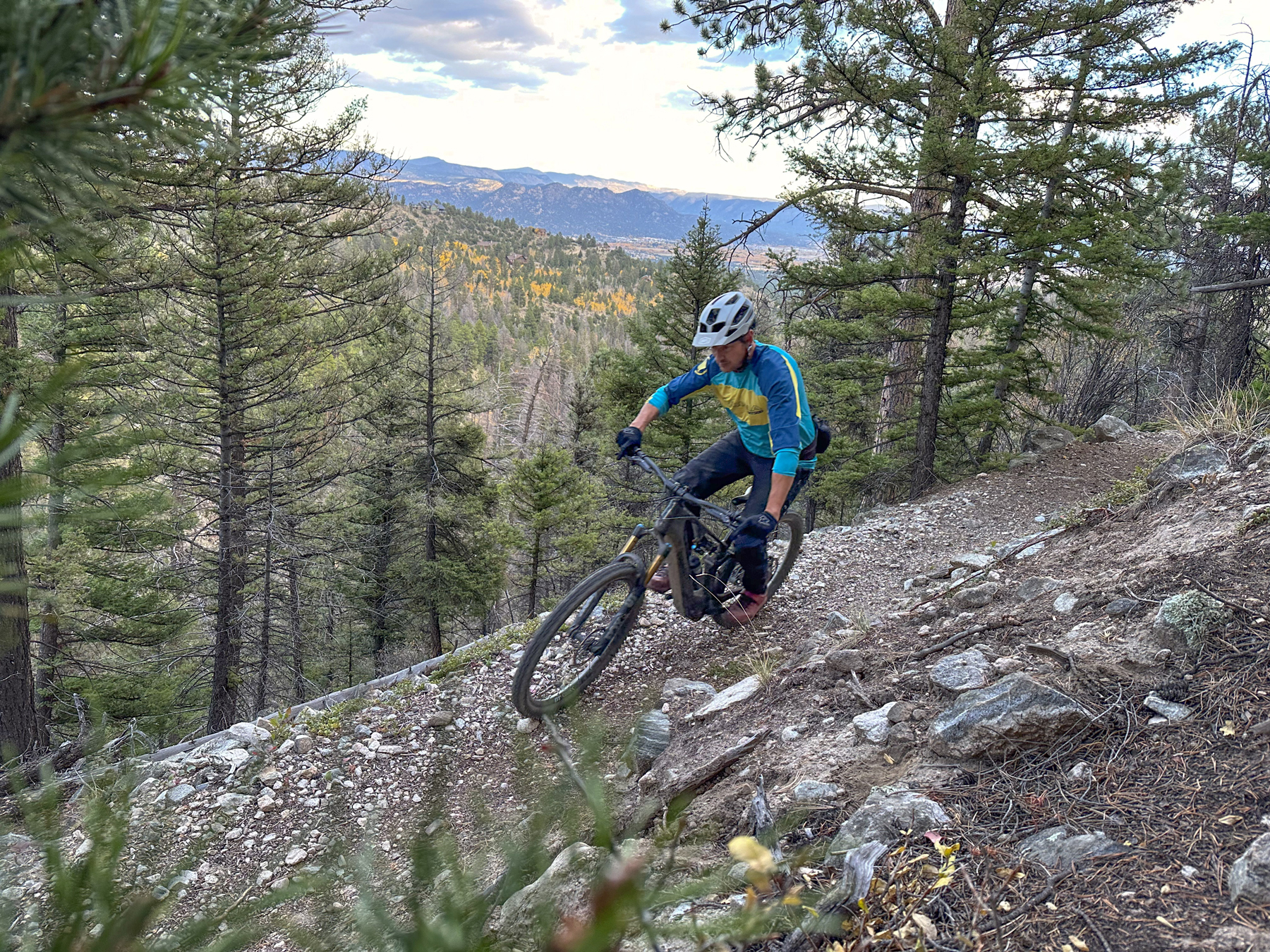
Throw away any notions you may have about flex-stays only belonging on light-weight cross-country race bikes because the Moterra SL’s FlexPivot 150 mm of travel is active, and sensitive, with plenty of support without feeling one bit harsh. Put differently, it doesn’t feel like most flex-stay suspension. We took it down some rowdy rocky trails and the suspension never seemed overwhelmed, even when trying to keep up with the exceptionally composed Mondraker Dune XR.
I found the difference between a 62.5º or 63.7º head angle not as noticeable going downhill as it is when climbing or in undulating terrain. The 63.7º setting offers more control in slower-speed situations, but both felt pretty natural once the speeds picked up a bit. Because I didn’t find a big performance benefit to the slacker head angle, I left it in the 63.7º setting.
I didn’t get the chance to ride the Moterra SL as a full 29er, so I’ll leave it up to Dylan to comment on that area of its performance.
When it comes to descending, Cannondale has the recipe just right for the kind of riding I like to do. The Moterra SL is poppy and playful, but not at the expense of stability — it feels more stable and has a higher speed limit than a lot of the mulleted eMTBs I’ve been on recently.
Dylan: Simon nailed it. The Moterra SL somehow does everything well, striking an extremely versatile middle ground in the Trail eMTB category. It handles steep, chunky, and fast terrain really well, but also has plenty of life and playfulness on flatter terrain.
Despite not having the most travel, I found myself liking the Moterra SL the most on steep, technical trails. Its very slack head tube angle and long wheelbase make it an incredibly confident descender, allowing you to get your weight very far back on the bike, and having the ability to confidently stay on line in even the steepest chutes. It doesn’t have the most plush, traction-rich suspension, but its very large sweet spot allows you to get away with imperfect riding in demanding terrain.
But, get this bike on a flowy trail without much pitch, and its responsive suspension platform and low weight (for a full-power eMTB) begin to stand out. The Moterra SL generates speed nicely when pumping, and is easier to get into the air than you’d expect.

I also found myself pretty indifferent to the two head tube angle options on the way down. The Moterra SL can feel a bit floppy in flat, sandy corners in the 62.5º setting, but other than that, I haven’t noticed as much difference on the way down as on the way up. It’s also worth noting that while the Moterra SL comes stock as a mixed-wheel bike, with a 27.5” wheel in the back, you can flip a couple of chips and run a 29er out back, too. The Moterra SL feels like it has a preference for a more forward weight bias in the full 29” setup, and it does feel slightly faster in straight lines and in chunky terrain. But, given how well this bike’s geometry is suited to steep terrain, I enjoyed it most in the mixed-wheel configuration, where it felt more comfortable in steep terrain due to a more rearward weight bias.
The Build
Simon: Cannondale did a solid job with the build on the Moterra SL1 we tested, which at $8,750 represents what I consider to be above-average value, and would be my pick of the three available builds.
The Fox Factory suspension is a standout, and is more common to see on eMTBs north of $10k. Historically, I’ve had good luck with DT-Swiss 1700 wheels, which use DT’s 350 hub with 36t ratchets and 10º of engagement. I’m always happy to see DT-Swiss star-ratchet hubs on the back of eMTBs since I think they are one of the more reliable hub systems on the market — an important consideration given they have to manage the additional stresses of a motor.`
We’ve mentioned in some of our eMTB reviews that SRAM’s AXS Transmission drivetrains are well suited to eMTBs due to their excellent shiting under load performance. The XO AXS Transmission on our Moterra SL is no exception and has performed beautifully throughout our time with it. The terrain we test in is a punishing environment for derailleurs and the Moterra’s has taken a beating and endured plenty of impacts. The frequent electrical noise of the override clutch doing its job keeping the derailleur safe is a good reminder of how well the SRAM Transmission works.

The only part I’m less enthused about is Cannondale’s DownLow dropper post. To be clear, it works exactly as it’s supposed to, but at only 170 mm of travel, it feels like not enough, and the drop force is on the high side which makes it feel slow to depress.
Dylan: Cannondale packs a lot of value into the Moterra SL 1. I probably wouldn’t change anything, apart from using tires with more durable casing, as I did get a puncture in the rear Maxxis Dissector with its stock EXO+ casing. I’d also prefer a dropper with more travel, which should be an easy swap since I had plenty of room above the seat collar with the stock 170 mm Cannondale DownLow dropper.
Simon: Like Dylan, I also have plenty of room above the seat collar with the 170 mm dropper post, but the Moterra SL has a pronounced kink in the seat tube that limits maximum seatpost insertion to 238 mm on the size Large (and Medium). When plugging that number, and my seat height measurement into the OneUp dropper post length calculator, it looks like 180 mm is the longest travel post that will work for me, and likely Dylan too since we have a very close seat height.
Drive System and Range
Simon: I’ve spent a good bit of time on the Shimano EP801 motor, and it matches up closely to the motors from Bosch, Specialized, and Rocky Mountain in terms of power and torque. We go into more detail on the Shimano drive system in our Pivot Shuttle LT review, but overall the EP801 ranks high on my list of preferred motors.
The power delivery on the EP801 isn’t quite as smooth as the Bosch CX motor, but interestingly I’ve found the EP801 to prefer a lower cadence, which is one of the things I like most about it, especially when climbing technical terrain. Knowing you’ll have a strong surge of power with just a slow rotation of the cranks really helps stay committed in slow, janky, high-consequence situations.
While the EP801 responds well to a slow cadence, it doesn’t particularly like an especially fast one. Spinning at over 100 RPM causes the power to drop off considerably, and going faster than that sometimes feels like you’ve the hit rev limiter in a car where the power cuts out abruptly. Just coming off riding a bike with the Bosch SX motor, where you have to a high cadence to extract all the power, I quickly had to make adjustments to my riding style.
As much as I like the motor, other components in the drive system could use some updates. I’m not a fan of handlebar-mounted displays in the first place, and if I am forced to have one, then it had better have all the information you need, like actual battery percentage — I can’t understand why the Shimano display doesn’t provide one of the most crucial bits of data when riding eMTBs.

In my opinion, displays should be integrated into the top tube and have a screen that offers all the information you need. Brands like TQ, Specialized, and Rocky Mountain do a nice job with their integrated top tube displays, whereas Shimano seems a bit off the back here, but to be fair, so is Bosch.
I also don’t find Shimano’s E-Tube Project app to be very intuitive to use, and it doesn’t give you actual battery percentage either — it’s like Shimano doesn’t want you to know how much actual power your battery has left.
For the most part, the Moterra SL’s range falls in between light-assist eMTBs and full-power eMTBs. Keeping the weight down was obviously part of the design brief for the Moterra SL, and when deciding to go with a full-power motor, the weight savings had to come from the battery. Cannondale partnered with battery maker Darfon to make the 601 Wh battery lightweight and energy-dense. The battery is a key contributor to the Moterra SL’s impressively low weight.
At the very end of our time with the Moterra SL, it started intermittently throwing an E914 code, which indicates an irregularity between the battery and the motor. When it happens, you temporarily lose assist and have to cycle the power button to bring the assist back on line. Following Shimano’s troubleshooting guide I removed the motor and checked/cleaned all the connections, which unfortunately didn’t remedy the issue, so it’s on its way back to Cannondale to get sorted. We will update this review when we hear back from Cannondale on what the fix is.
Dylan: This was my first time on the Shimano EP801 system, and overall, I’m quite happy with it. On the trail, it delivers excellent, powerful assist, allowing the lightweight Moterra SL to climb just about anything. Generally, the only times I ran into issues cleaning a steep or technical climb were because of my inability to keep the powerful Moterra SL on the trail or just the right line, with the bike sometimes feeling like it was getting away from me. I also sometimes ran out of traction, with the powerful EP801 system sometimes causing the rear wheel to spin out. But, if you’re smooth and precise on the Moterra SL, it’ll take you up some seriously trickly climbs that even dirt bikes struggle to ascend.
The only issue I personally ran into was that the walk mode would sometimes be extremely weak and slow. Turning the bike on and off would usually solve this, but it’s obviously still not ideal for the walk mode to be inconsistent. When it was working right, the walk mode is very powerful, usually faster than I am when walking up extremely steep trails. I also agree that the EP801 system should provide an exact battery percentage, but I was happy with the information available on the display screen otherwise.

Range-wise, I found the Moterra SL’s limits at around 15-20 miles, or ~3,500-4,000 feet of climbing. I’m sure you could squeeze out more miles on flatter trails, but overall, I was happy with the Moterra SL’s range given its low weight. I do think Cannondale is really missing the mark by not offering a range extender for the Moterra SL, as I definitely would be happy to carry an extra 4 or so pounds for ~300 or so more watt-hours.
Who’s It For?
Simon: Anyone looking for a lively, engaging full-power lightweight eMTB with do-it-all capability, and a talent for making any trails fun. The Moterra SL also offers an appealing option for folks who are on the fence between light-assist and full-power eMTBs.
Dylan: Folks who are after a full-power eMTB but want something considerably lighter than other options could be well-served by the Moterra SL. This bike does sacrifice some range in order to achieve its impressive sub-46 lb weight, but that’s about the only sacrifice it makes. The Moterra SL handles a really wide variety of trails quite well, from ultra-steep gnar to mellow flow tracks, and it’s very hard to get this bike to feel out of place.

Bottom Line
The Moterra SL made quite an impression on us — it is an incredibly fun bike in just about any situation. If it had just a wee bit more range it would be almost impossible to beat for a one-bike eMTB quiver. But what the Moterra SL may lack in range is more than made up for with its balanced performance across the board, as it turned out to be a much more versatile bike than we thought it would.
The Moterra SL occupies a unique space somewhere in between light-assist and full-power eMTBs, and for the time being, it’s all alone there — we’ve really enjoyed our time on it and are sad to see it go.
Deep Dive Comparisons
BLISTER+ members and those who purchase our Digital Access Pass can check out our Deep Dive comparisons linked below. Get our Digital Access Pass to view all our Deep Dives and Flash Reviews, or become a BLISTER+ member today to get access to that and a LOT more, including the best worldwide Outdoor Injury Insurance, exclusive deals and discounts on skis, personalized gear recommendations from us, and much more.

Deep Dive: Cannondale Moterra SL
We compare the Cannondale Moterra SL to the Pivot Shuttle LT, Pivot Shuttle AM, Orbea Wild, Devinci E-Troy, Rocky Mountain Instinct Powerplay, and Mondraker Dune XR.
Blister’s Flash Reviews and Deep Dives are accessible to those who purchase one of our paid subscriptions
To get our comprehensive Deep Dives and our initial, unfiltered reports on new gear, become a member and receive many other services, deals, and discounts.
If you’re already an active member, please log in.
(If you’re already logged in and a member in good standing and seeing this message in error, please refresh this page in your browser.)


Fantastic looking bike. I’m too interested in knowing what the dropper insertion is. My current bike is a small Marin Alpine trail, 445mm reach, 390mm straight seat tube 180mm dropper… so I’d probably pick a Medium, but would need to fully insert the 170mm dropper and that’s not looking likely.
Any thoughts on dropper insertion?
We should be getting one in for review pretty soon, so we’ll be able to dig into that detail more. Stay tuned.
Looks intriguing. FWIW, Giant’s Trance Advanced E+ (yes, that is the name of a bike) is another lightweight, full-powered e-bike. My wife rides the Liv version, and the only shortcoming is the 400 battery, though with her weight, it easily lasts for three hour plus rides. Killer sale on them right now.
Have you heard back any news from Cannondale about the e914 error?
Is Large too small for 6’2 person? The 1320+ wheelbase on XL is scary for everyday rides. Like a boat
Any update on the E914 issue? It seems to be prevalent with these bikes. I have one that I’m about to make my third warranty claim on. So far it’s gotten a new battery and a new drive unit.
In regards to the E914 code, here is the official statement from Shimano: “Shimano is constantly evaluating the performance of our products as well as third party products that are used alongside our components. The E914 error code has been associated with specific third party batteries used with Shimano e-bike systems and we are working with these partners to fix the issue. Any rider who experiences the E914 error code can contact Shimano Customer Service where we support Shimano Connected Partners and related products.”